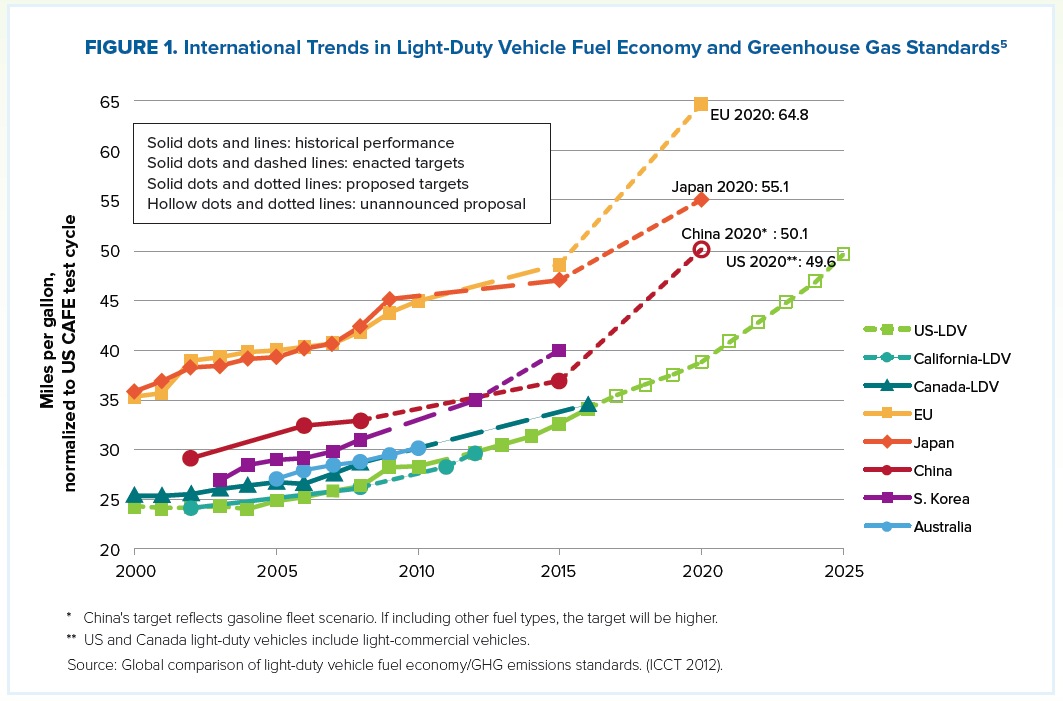BLUEGREEN ALLIANCE
Executive Summary
In 2011, the U.S. Department of Transportation (DOT) and Environmental Protection Agency (EPA) proposed joint fuel economy and greenhouse gas pollution standards for new cars and light trucks.
These proposed standards would reach the equivalent of 54.5 miles per gallon (mpg) and 163 grams of carbon dioxide per mile (g/mi) for the average new vehicle in 2025. Hereafter we refer to these proposed joint fuel economy and greenhouse gas pollution standards simply as “the proposed standards.” In this report, we analyze the macroeconomic impacts of the proposed standards with particular attention to the net gain in U.S. employment.
Our analysis finds that the proposed standards will create an estimated 570,000 jobs (full-time equivalent) throughout the U.S economy, including 50,000 in light-duty vehicle manufacturing (parts and vehicle assembly) by the year 2030. Real wages are projected to increase even faster than job growth. This implies that the proposed standards will both lead to new jobs and, on average, higher-paying jobs across the U.S. economy. By 2030, we also find a net increase of about $75 billion in annual Gross Domestic Product (all monetary values in 2010 dollars).
The proposed standards create jobs by helping to save drivers money on transportation fuel through improved average fuel economy over time and increased variety of more fuel-efficient vehicles. These new, more fuel-efficient vehicles are incrementally more expensive due to technology upgrades, but fuel savings are expected to more than outweigh the added cost. Fuel and cost impacts and other assumptions are harmonized with the assessments of the relevant federal agencies to the greatest extent possible.
It is important to keep in mind that the proposed standards we analyze cover the period 2017-2025, building on the 2012-2016 standards, so the economic benefits quantified here are only a fraction of the total benefits that will be delivered by stronger performance standards for vehicles. The 2016 standards themselves would be expected to deliver greater job growth and other macroeconomic benefits than the proposed standards since the net fuel savings (fuel savings minus costs) are even higher for that regulation.
Vehicle manufacturing has been one of the country’s top performing sectors in recent years. From the seasonally-adjusted low point of June 2009 through May 2012, the nation gained 146,000 jobs in motor vehicle manufacturing (including parts suppliers) and when auto dealers are included the job gains amount to 219,000. The nation’s largest automakers are investing billions in retooling and expanding to produce the cleaner cars that consumers are demanding.
It’s not just domestic consumers that are demanding cleaner, more fuel-efficient vehicles. An underappreciated benefit of the proposed standards is that they will close the gap between U.S. standards and those of other major car markets, including China, Japan, Korea, and the European Union. All these countries have more ambitious vehicle performance standards than the U.S., and they will continue to outperform the U.S. in this area even assuming the proposed standards are implemented. However, the proposed standards will bring U.S. vehicle performance closer to that of other major auto producers, ensuring steady progress toward greater harmonization with potential export markets. This should strengthen the position of U.S. vehicle makers in the international market.
To further explore potential economic benefits of the proposed standards, we consider two alternative auto-manufacturing scenarios in addition to our main policy case. We investigate the manufacturing employment results that would follow from increased vehicle sales. We estimate that if light-duty vehicle sales were to increase by 4 percent in 2030, light-duty vehicle manufacturing employment would increase by 19,000.
We also explore the question of how many more jobs would be created if the domestic content (the amount of a vehicle’s value that is produced in the United States) could be increased. We focus on one slice of the lightduty vehicle market, the jobs associated with the new more fuel-efficient technologies that will be used to achieve compliance with the new standards. Currently about 60 percent of the value added in light-duty vehicle production is captured domestically, so we assume that as the starting point for the manufacture of new energy-efficient technologies analyzed in this scenario. We find that if domestic content for these new components was to increase to 75 percent in 2030, then about 4,100 jobs would be added in light-duty vehicle manufacturing (including parts suppliers). The economic ripple effects create jobs in other sectors of the economy amounting to 9,000 jobs, more than twice the number of jobs directly created.
Our domestic content scenario is not a prediction but a what-if scenario. It illustrates the benefits that would follow from a trend toward higher domestic content. What could actually bring such a result about? Smart policy is crucial. There is an immediate need for the Department of Energy to process and disperse funding already allocated to the Advanced Technology Vehicle Manufacturing Program. Policies that support greater industrial energy efficiency will also assist international competitiveness by lowering long run energy costs and reducing vulnerability to energy fuel spikes. In the preface to the report, David Foster sketches a larger policy vision for capturing more of the manufacturing jobs associated with the transition to cleaner energy.
Download full report (PDF): Gearing Up: Smart Standards Create Good Jobs Building Cleaner Cars
About BlueGreen Alliance
www.bluegreenalliance.org
“The Blue Green Alliance is a national, strategic partnership between labor unions and environmental organizations dedicated to expanding the number and quality of jobs in the green economy.”
Tags: BlueGreen Alliance, Greenhouse Gas







 RSS Feed
RSS Feed